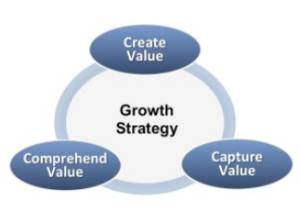 I seem to be reading a lot about the concept of value creation recently.
I seem to be reading a lot about the concept of value creation recently.
It seems to have the same ‘heady vaulted position’ as innovation in that we all talk far more about the ‘promise’ of it. So what is behind value creation?
What drives it? What will allow us to stand out as the place to invest in?
So what is value creation?
Value creation is highly dynamic, it is going on all the time and can increase, decrease or transform in different ways when you exploit your different capitals that will change and reflect your organization’s business activities and eventual outputs.
This is when you can begin to see the value created by the use of deploying all the capitals.
Value is not just from within, it is the links our organizations are constantly making with others, in the interactions, relationships and the combining of the activities. The important need is to manage the stocks and flows of the capitals
The role of all the capitals is crucial to understand, they create or destroy value. It is the constant flow between all the capitals deployed that makes up the value creation process.
Our management within our organizations needs to know where this real value creation resides.

Understanding all the make up of capitals needs to be approached in practical ways.
The place to focus is on recognizing the material components of what is making up the specific value creation aspects that will provide benefits that have been captured, understood, maintained and then enhanced for the additional value creation
Clearly the ultimate objective is to enhance the organizations abilities in the longer-term to appreciate the growth strategy. The more we know as outsiders of the value creation process the more likely this will attract a greater investment. Often this is determined by the final product, service or business model outcome.
Today we lack the measures to judge longer-term adequately enough and organizations are judged on their innovation activity going through the pipeline and that judgement often lacks the real make up of the application of the different capitals.
Greater engagement or not?
We can leave this to the management, just sit back and simply expect increased dividends but will not enjoy many of those nasty surprises when the results fail to materialise.
The argument is that the investors, the stakeholders within a business, need to understand the business logic far more, to make a more informed decision to continue to invest or partner with a particular organization.
Knowing the successful generation of all the intangible values and their transformation into tangible forms and how this is systematically being harnessed tends to confirm the realization of the business goals or what the possible risks are.
Organizations are certainly fairly reluctant to discuss these except behind closed doors to selected investment parties in their investors briefings.
Making these more visible, leads to greater accountability and to be ‘accountable’ you need to understand the make up of your capitals.
The present incentive for business organizations to become more vocal in explaining their business models, their process for value creation and offering more insight on all their capitals is their need to grow and that comes from investors wanting to invest!
Exposing the softer side of value creation is the key.

The need is to understand value creation is coming from the ‘softer’ side, the often intangibles that remain hidden for the real value enhancing aspects of a business.
These need drawing out more.
The real capital that contributes to value creation is coming from knowing answers to these questions offered below.
Many of these can be reported upon and that would enhance the understanding and attract investment.
Thoughtfully measuring and reporting upon these builds that external confidence that the business is focusing on the sustaining values relevant to its goals and growth objectives.
These can include but are not limited to:
- The ways an organization is setting about combining and utilizing networks and relationships
- How are they actively advancing their creative and innovation capabilities and competences? Are there specific frameworks and approaches.
- The ways they are actually seeking out in explicit ways that deepening of customer understanding
- The purposefully ways that reputation is being protected, quality in being enhanced
- How are the brands protected, enhanced and improved to add increasing value
- How they are capturing new knowledge internally and the ways this flows and gets translated into new value through specific value enhancing stores.
- How the focusing on social issues and values is contributing into society and equally underpinning their value into both local and global communities
- What are the plans and intent to link social, environment and harness the intellectual capitals, to enhance and strengthen society and the organizations linkage, and the outcomes being achieved.
- Where they are recognizing, strengthening and exploiting the value chain linkages
- Providing a greater depth of explaining and extending the organizations skills and capacities to learn and absorb, through advancing specific capabilities, and deepening capacities.
- How it continues to build loyalty and trust and what aspects need repairing or renewing due to difficult decisions or changing circumstances, showing a clear pathway of achieving this responsiveness and flexibility.
- How and where does innovation fit, for achieving the growth perspectives and discussing any shortfalls, through prescribed or alternative actions. Are you building a common sense of innovation purpose?
- Are there explicit innovation competencies, processes and governance actively being managed, that provide support to the activities being undertaken and being consistently risk assessed. What is the risk appetite for innovations? How is this managed?
- Lastly what they are exploring in the different forms of evaluation, experimentation and ongoing assessment to ‘measure’ the real underlying asset wealth of the organization.
This is their learning journey and its growing value to all associated with this to achieve that better visibility into our organizations.
Better outcomes and a greater relationship between investors and the organization needs to be achieved. I think it is possible but it is a journey many are reluctant to travel.
The emergence of the business narrative to help us.

Telling the organization story is becoming important. Our organizations need to shift their orientation and begin to provide a better, more compelling story of their business.
Perhaps the following attributes might be the place to start building a better business narrative for others to understand what is driving value creation.
This can be reflected upon in some of these suggested ways as a guide to begin in telling the unique story that makes up your organization, against another:
- More offering a predictive value that ‘projects’ the future
- Explaining how something is being achieved and will be further strengthened.
- The critical importance of explaining the context that made or makes up decisions
- Placing the emphasis on direction and not precision
- The explicit linking of strategy and execution
- The use of existing systems and processes and their life-cycle
- Offering a view on emerging and perhaps more complex systems and processes with their future fit, and what this might have in organization implications.
- The shaping of the organization’s behaviour, what is influencing and shaping it
- Enough detail to be comprehensive, comprehensible but still delivered with simplicity.
There is a growing public demand to know where the value creation is coming from and what the management of our organizations is doing to protect and enhance it. Knowing the makeup of the material capitals is so important to this.
It is the input of the capital and the processes in place that will provide outputs and eventual outcomes and that broader knowledge about the ‘inner workings’ gives us the deeper belief that value creation has a greater chance of being sustained, allowing us to better judge continuance to invest or to exit.
I see value creation arising from two sources; value management – listening to customers and meeting those explicit needs, or value leadership – delivering products or services which satisfy latent needs to customers that they are not able to explain.
Let me offer a more simplistic view. Value creation comes from providing true, tangible and transformational benefits to your customers (or buyers) net of your costs.
Value Creation = Benefit – Cost
Value Creation = (Benefit – Price) + (Price – Cost)
Value Creation = Value to customers + Value to the company
The end goal of value creation is to maximize the value for customers as well as the enterprise.
– Sanjiv Karani